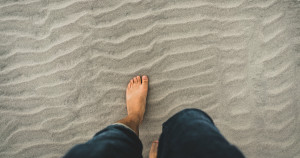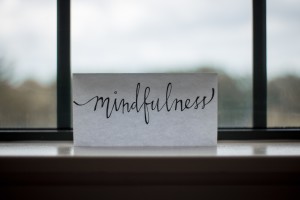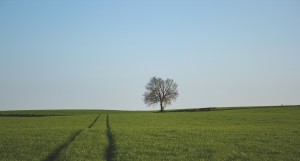There are a million different ways to practice walking meditation. But all of them are rooted in the basics of mindfulness: being aware with a curious & equanimous attitude.
What follows is a way of practicing walking meditation that I’ve found particularly helpful, both for “beginning” and “advanced” meditators.
I like to think of this practice in terms of layers. Each one is a perfectly great practice on its own, though they can also all work together (sort of like how different instruments can create beautiful sounds by themselves, but can also mesh with other instruments to create a “song”).
I’d recommend starting with layer 1 or 2, and only adding other layers once you’ve gotten the hang of the previous.
Finally, while this might be obvious, a big part of meditation is learning to actually show up for our life, so put away the phone and electronics, and just be present with what’s real!
 Layer 1 — Stay conscious of how are you walking
Layer 1 — Stay conscious of how are you walking
What pace are you walking at? Are you slouching or upright? Are you walking gracefully or sloppily? Do your movements feel natural and easeful?
Play around with these questions until you find a walking “sweet spot” that feels both relaxed and energized. From here, the practice is just to monitor how you are walking, and notice every time you drift away from your “sweet spot.” Instead of criticizing yourself when you do, just gently & lovingly shift back.
 Layer 2 — Anchor awareness in your footsteps
Layer 2 — Anchor awareness in your footsteps
Sometimes, noticing how you are walking can feel a little abstract. It can be really helpful to have something more solid and tangible to work with. I’d recommend gently noticing the pressure of every footstep on the ground. You could precisely notice where on your foot you feel the pressure, or just be generally aware of left, right, left, right, etc.
If you ever drift off into thoughts or reactivities, just gently & lovingly bring your attention back to your footsteps.
 Layer 3 — Keep your eyeballs still
Layer 3 — Keep your eyeballs still
One of the main challenges of mindful walking is that our eyeballs tend to bounce all over the place. They want to see and experience the myriad things in you field of vision, including trees, cars, animals, colorful houses and all the interesting people.
This is such an unquestioned habit of ours that it can be helpful to reflect, “does looking at all these things really give me happiness?”
If you come to the answer, “not really… at least not as much as staying peacefully mindful,” then read on.
In the yoga tradition, there’s a Sanskrit term called “drishti,” which roughly translates as “gazing point.” It refers to some neutral object that we can rest our eyeballs on.
For example, while walking down a residential street, you might notice a stop sign, large tree or telephone pole a block ahead of you. For that block, you use that single object as your “gazing point.”
This doesn’t mean you laser focus your vision on that object. It’s much softer and gentler, and you also stay loosely aware of the periphery (you don’t want to trip and fall, get hit by a car, or walk into a bush!).
In other words, you’re not actually trying to be specifically aware of that gazing point. Instead, you’re just using it as a way to keep your eyeballs relatively still, so they don’t bounce all over the place and steal your mindfulness. Doing this makes it incredibly easier to be aware of how you’re walking, or the pressure of your footsteps.
 Layer 4 — Verbalizations (for when the mind is chaotic)
Layer 4 — Verbalizations (for when the mind is chaotic)
Sometimes your mind will be a bit scattered, and even if you try and do the previous three layers, you will still pass most the time wandering off into thoughts and reactivities.
Once again, the most important thing to do is be gentle and loving towards yourself. This is just what minds do—they wander! The fact that you are noticing it is really powerful!
Although, beyond self-love, there are specific techniques that can give you a roughly 25% mindfulness boost, even when your mind is chaotic. I’ve found the best ones involve using words, either counting or labeling.
With counting, if you are walking down the street, you could count your footsteps, thoughts, sounds-you-perceive, seconds, moments of spaciousness, or anything at all.
With labeling, if you are walking down the street, every 1 to 5 seconds, label something you notice—thinking, tingling, sound, pressure, footstep, pulsing, hearing, fear, sadness, hurrying, footstep, etc.
You could verbalize silently or outloud.
 Layer 5 — Awareness of Awareness (for when the mind is calm)
Layer 5 — Awareness of Awareness (for when the mind is calm)
Ultimately, meditation is not about doing a bunch of fancy techniques. It’s about dropping into the simple awareness of the here-and-now (with a curious and equanimous attitude!).
When the mind isn’t consumed with internal noise, it takes almost no effort to be aware and stay aware.
In turn, if your mind is pretty calm, and you’re finding it relatively easy to stay present, then the previous layers are largely unnecessary. In that case, I’d recommend just resting back into the flow of awareness, and becoming aware of the fact that you are aware. Notice the quality of lucidity and vividness. Notice the sense of flow.
Try it out right now for the next 10 seconds. What are you aware of without even trying? The sounds in the room? The visuals behind the screen? The feel of your body?
Relax into that effortless awareness.
In walking meditation, notice every time you lose it. Notice every time it comes back. Notice how long it sticks around. Notice how long it stays away. Notice the mechanics of how grasping and reactivity try to take over awareness. Notice how the simple act of noticing the grasping and reactivity can be enough to stay aware.
Note: it’s really easy to delude ourselves into thinking we can just relax into effortless awareness and actually stay highly aware. In turn, while this layer can be practiced entirely on its own, it also requires a high level of self-honesty, and a willingness to shift to another layer when thoughts and reactivities get a little stronger.
 Other Considerations
Other Considerations
1) Deciding to meditate
We spend all day walking around. The basic way to shift from “ordinary walking” to “walking meditation” is to actively decide to meditate. For example, you might pause for a moment, and say, “from this door until my car, I will practice walking meditation.”
Even with all my meditation experience, I find that if I don’t actively decide to do walking meditation, it’s much more likely that I’ll spend my walking time drifting in thoughts and reactivities.
In other words, set the intention!
2) Formal vs. informal walking meditation
Any time you are walking is a good time for informal walking meditation. This could be at work, in your neighborhood, on the way to your car, in your house or strolling with a friend. It’s basically doing the same thing you always do, walking, but with the intention to drop into the above layers.
Formal meditation usually refers to walking back and forth for a set period of time. You might have a walking path of 10-30 feet, and just pace from one side to the other, usually pausing at each end of the path for a few moments.
3) Is walking meditation as good as sitting meditation?
There’s a common belief that sitting meditation is the “best” form of meditation. However, it’s actually a completely false belief. Meditation is just about being aware with a curious & equanimous attitude. This is absolutely possible to do while walking.
In fact, the most significant meditative insight of my life came while I was doing walking meditation. The form isn’t important. The quality of your mind is.
In other words, lean into walking meditation as much as possible, and it can take you all the way!
 Conclusion — Don’t overthink it!
Conclusion — Don’t overthink it!
It might seem like there was a lot of information here, and perhaps you feel a little overwhelm.
However, always remember just how simple this practice actually is: being aware with a curious & equanimous attitude.
Any one of these layers is fine by itself. Just start by noticing how you are walking, or by grounding your attention in your footsteps. Everything builds from there.
One step at a time!
